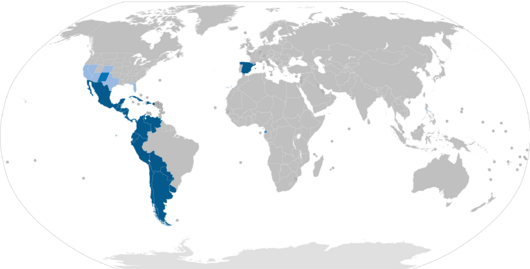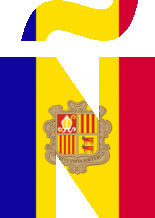List of countries and territories where Spanish is an official language facts for kids
The following is a list of countries where Spanish is an official language, plus several countries where Spanish or any language closely related to it, is an important or significant language.
Contents
Official or national language
Spanish is the official language (either by law or de facto) in 20 sovereign states (including Equatorial Guinea, where it is official but not a native language), one dependent territory, and one partially recognized state, totaling around 442 million people.
Primary or only official language
In these countries and territories, Spanish is the main or mostly used language of communication of the vast majority of the population; official documents are written chiefly or solely in that language; and it is taught in schools and utilized as the primary medium of instruction as part of the official curriculum.
Sovereign states
| Sovereign state | Status | Population (2021) |
Regulatory body | More information |
|---|---|---|---|---|
| De facto | 130,207,371 | Academia Mexicana de la Lengua | Mexican Spanish | |
| De jure | 52,695,952 | Academia Colombiana de la Lengua | Colombian Spanish | |
| De jure | 48,797,875 | Real Academia Española | Peninsular Spanish | |
| De facto | 45,864,941 | Academia Argentina de Letras | Rioplatense Spanish | |
| De jure | 32,201,224 | Academia Peruana de la Lengua | Peruvian Spanish | |
| De jure | 29,069,153 | Academia Venezolana de la Lengua | Venezuelan Spanish | |
| De facto | 18,307,925 | Academia Chilena de la Lengua | Chilean Spanish | |
| De jure | 17,422,821 | Academia Guatemalteca de la Lengua | Guatemalan Spanish | |
| De jure | 17,093,159 | Academia Ecuatoriana de la Lengua | Ecuadorian Spanish | |
| De jure | 11,758,869 | Academia Boliviana de la Lengua | Bolivian Spanish | |
| De jure | 11,032,343 | Academia Cubana de la Lengua | Cuban Spanish | |
| De jure | 10,597,348 | Academia Dominicana de la Lengua | Dominican Spanish | |
| De jure | 9,346,277 | Academia Hondureña de la Lengua | Honduran Spanish | |
| De jure | 7,272,639 | Academia Paraguaya de la Lengua Española | Paraguayan Spanish | |
| De jure | 6,528,135 | Academia Salvadoreña de la Lengua | Salvadoran Spanish | |
| De jure | 6,243,931 | Academia Nicaragüense de la Lengua | Nicaraguan Spanish | |
| De jure | 5,151,140 | Academia Costarricense de la Lengua | Costa Rican Spanish | |
| De jure | 3,928,646 | Academia Panameña de la Lengua | Panamanian Spanish | |
| De facto | 3,398,239 | Academia Nacional de Letras | Uruguayan Spanish | |
| De jure | 1,468,777 | Academia Ecuatoguineana de la Lengua Española | Equatoguinean Spanish | |
| Total | 464,509,172 | Association of Academies of the Spanish Language |
Territory
| Territory | Status | Population (2021) |
Regulatory body | More information |
|---|---|---|---|---|
| De jure | 3,142,779 | Academia Puertorriqueña de la Lengua Española | Puerto Rican Spanish |
Secondary official language
Spanish is a secondary language, co-official with Arabic as the primary language.
Partially recognized state
| State | Status | More information |
|---|---|---|
| De facto | Saharan Spanish |
Notes:
Significant language
Though not an official language at the national level, Spanish is regularly spoken by significant populations throughout these countries. Public services, education, and information are widely available in Spanish, as are various forms of printed and broadcast media.
| Territory | Population (2022) |
Total speakers | Percentage Spanish-speaking |
|---|---|---|---|
| 85,468 | ~40,000 | 48.6% | |
| 419,137 | 165,296 (year 2010) | 56.6% (year 2010) | |
| 34,003 | 25,500 | 75% | |
| 339,665,118 | ~60,000,000 | 19% |
Andorra
Spanish is not the official language of Andorra but holds a special status in some fields, namely in education and business. Public education in Spanish (following the Spanish public education system) is offered in the country. It is the second-most spoken language in the country, with nearly half of the population conversant in Spanish, rivaling the official Catalan in both native and total speaker numbers. Spanish has also emerged as the lingua franca between various linguistic groups and in the commercial sector, which has triggered government efforts to promote the more general and universal use of Catalan. In 2008, 30.8% of students were enrolled in the Spanish education system.
Belize
Spanish has no official recognition in the Central American nation of Belize, a Commonwealth of Nations member state where English is the official national language. However, the country shares land borders with Spanish-speaking Mexico and Guatemala and, per the 2010 Belizean census, Spanish is spoken by a sizable portion of the population; 30% claim Spanish as a mother tongue and about 50% of the population has a working knowledge of the language. The Census Report 2010 reported that 56.6% of Belizeans spoke Spanish.
Gibraltar
Spanish is not official in the British Overseas Territory of Gibraltar, which shares its only land border with Spain. Nevertheless, Spanish is compulsory for secondary school students and a mixture of Spanish and English called Llanito is colloquially spoken among most inhabitants. Recent trends since the 2000s have found, however, that Spanish proficiency and usage among younger generations is declining as members of these groups tend to use English exclusively.
United States
Spanish has been spoken in the United States for several centuries in the Southwest and Florida, which were all once part of New Spain. However, today only a minority of Spanish speakers in the U.S. trace their language back to those times; the overwhelming majority of speakers come from recent immigration. Only in northern New Mexico and southern Colorado there have been Spanish-speaking communities uninterruptedly since colonial times.
Spanish is the most studied foreign language in United States schools and is spoken as a native tongue by 41 million people, plus an additional 11 million fluent second-language speakers. Though not official, Spanish has a special status in the American state of New Mexico. With almost 60 million native speakers and second language speakers, the United States now has the second-largest Spanish-speaking population in the world after Mexico. Spanish is increasingly used alongside English nationwide in business and politics. Media in Spanish has also become influential outside of native Hispanophone circles. In the United States, correct use of the language is advocated by the North American Academy of the Spanish Language.
Officially recognized status
Philippines
Spanish was the official language of the Philippines from the beginning of the Hispanic period in 1565 and through independence until a constitutional change in 1973. However, President Ferdinand Marcos had Spanish redesignated as an official language under Presidential Decree No. 156, dated 15 March 1973 and Spanish remained official until 1987, when it was re-designated as a voluntary and optional auxiliary language. Additionally, the present Philippine Constitution, in its Article XIV, stipulates that the Government shall provide the people of the Philippines with a Spanish-language translation of the Constitution. The article was invoked and applied when, in 2015, Senator Loren Legarda introduced a Senate Bill requesting an act intended to provide translations of the Philippine Constitution into several specific languages, including Spanish. The bill was accepted and approved. Beyond the Constitution, the Philippine Department of Education issued DECS Order No. 33 in 1987, requiring schools to include Spanish and Arabic when offering foreign language courses, pointing out the relevance of both languages "in the development of Philippine history and culture".
On 8 August 2007, President Gloria Macapagal Arroyo announced that the Philippine government asked for help from the Spanish Government in her plan to reintroduce Spanish as a required subject in the Philippine school system. By 2012, the language was a compulsory subject at only a very select number of secondary schools. Despite government promotion of Spanish, only about 400,000 people, which accounts for under 0.5% of the population, can speak Spanish at least proficiently.
While Spanish is designated as an optional government language in the Philippines, its usage is very limited and not present in everyday life. Despite this, Tagalog and other native Philippine languages incorporate a large number of Spanish loanwords, as a result of 300 years of Spanish influence. In the country, use of correct Spanish is promoted by the Philippine Academy of the Spanish Language.
Other legal status
Western Sahara
Spanish is an official language, alongside Arabic, of the Sahrawi Arab Democratic Republic, a partially recognized state that claims Western Sahara. The territory, a former Spanish colony now mostly occupied by Morocco, is regarded as a non-self-governing territory by the United Nations. Although Spanish is not commonly spoken as a native language in Western Sahara, it is widely used as a secondary language in the region's SADR-controlled area, while the Moroccan government uses Arabic and French in administrating the Moroccan-occupied area.
Creole languages
There are several Spanish-based creole languages. Chavacano is spoken in Zamboanga City in the Philippines and is a regional language. Papiamento is the official language in Aruba, Bonaire, and Curaçao; it has been classified as either a Spanish-based or a Portuguese-based creole.
Chamorro is an Austronesian language with many Spanish loanwords; some scholars have considered it a creole, but the most authoritative sources deny this.
| Country | Creole language | Estimated speakers |
Year | Status |
|---|---|---|---|---|
| Papiamento | ~100,000 | N/A | Official | |
| Papiamento | – | – | Official | |
| Papiamento | 185,155 | 1981 | Official | |
| Chavacano | 689,000 | 1992 | Regional |
Judeo-Spanish
Judeo-Spanish (sometimes known as Ladino or other names) is a language derived from medieval Spanish; it is still spoken by some Sephardi Jews, mainly in Israel.
International organizations
- United Nations (UN)
- European Union (EU)
- Union of South American Nations (UNASUR)
- African Union (AU)
- Central American Integration System (SICA)
- Latin American Parliament (Parlatino)
- United Nations Economic Commission for Latin America and the Caribbean (ECLAC)
- Organization of American States (OAS)
- Organization for Security and Co-operation in Europe (OSCE)
- Organization of Ibero-American States (OEI)
- World Trade Organization (WTO)
- North American Free Trade Agreement (NAFTA)
- Mercosur
- Andean Community of Nations (CAN)
- Caribbean Community (CARICOM)
- Latin American Integration Association (ALADI)
- Antarctic Treaty Secretariat (ATS)
- International Labour Organization (ILO)
- Food and Agriculture Organization (FAO)
- International Telecommunication Union (ITU)
- Latin Union
- Pacific Alliance
- Interpol
- Fédération Internationale de Football Association (FIFA)
- Inter-American Development Bank
- World Tourism Organization (UNWTO)
See also
 In Spanish: Anexo:Países donde el español es idioma oficial para niños
In Spanish: Anexo:Países donde el español es idioma oficial para niños
- Hispanophone
- Geographical distribution of Spanish speakers
- Spanish-based creole languages




